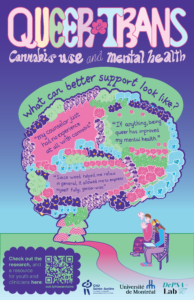Queer and trans cannabis use and mental health
A discussion cheat sheet for queer and trans youth and mental health providers supporting us
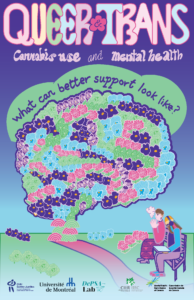
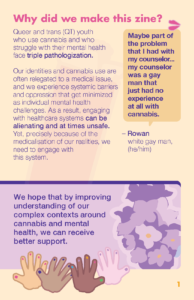
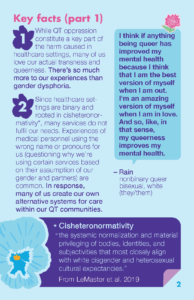

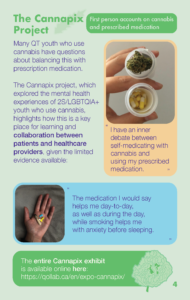
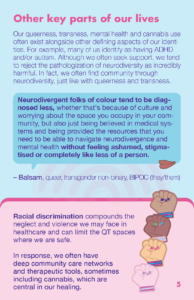

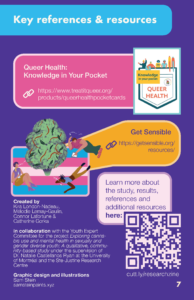
Click here for the full zine:
Special thanks to Sam Stein for illustrating and designing this zine.
Why did we make this resource?
Bridging the gap between queer and trans (QT) youth and the mental health providers who wish to support us can be tricky – that’s why we created this zine! We’re a group of QT youth who led interviews in our community. In this zine, we present some of our results alongside findings from the literature and thoughts to better our therapeutic relationships.
We made this zine as a tool for all of us involved in these conversations based on the assumption that we’re all trying to learn, and see QT youth who consume[d] cannabis receive better mental health care.
Some key points:
Contextualising queer and trans healthcare realities
Navigating the health system as a young queer and/or trans (QT) person is particularly hard. These spaces are set up according to binaries based on sex assigned at birth, disregarding gender and sexual diversity. As a result, these spaces are exclusionary to many people in our communities. Throughout history, our identities have long been pathologized (and theorized – with a number of research efforts seeking to elucidate “why” queerness or transness occurs, a question that does not serve QT people). Homosexuality was only removed from the Diagnostic and Statistical Manual of Mental Disorders in 1973, whereas gender dysphoria, which is necessary for many trans people to receive health care, remains a diagnosable disorder.[1][2][3] Considering this, it’s no surprise that many of us feel misunderstood, invisible or even unsafe in the healthcare system.
The research unequivocally supports this – we consistently report more dissatisfaction and unmet healthcare needs.[4][5][6] Sometimes, some of us are lucky and get the support of a mental health provider who is well-versed in our realities and understands sexual and gender affirmative care (and doesn’t blame all our issues on our sexuality or gender). However, we often have to find other ways outside of institutionalized mental health systems to care for ourselves and others. Ironically, these alternative survival and support strategies we adopt are then pathologized when we interact with institutionalized mental health care, which furthers the cycle of alienation.
How does cannabis use feature in our communities?
One of the ways in which the research suggests we create alternative mental health strategies is through cannabis use.[7][8][9][10] Indeed, as a group, we have higher rates of cannabis use,[11][12] higher rates of mental health challenges,[13][14][15] and we also experience the combination of these more frequently than our cisgender and heterosexual peers.[16][17] Although it may be tempting to limit cannabis to the role of self-medication considering these statistics, the picture is much more complex. We also use cannabis to facilitate introspection, connect with queer and trans community, and experience our bodies and gender presentation in ways that are less constricted by the forces of cisheteronormativity*. There are many of us, however, who do not use cannabis and it would be disingenuous to ignore how for some, our relationships with cannabis are complicated. Regardless of our unique relationships and motivations, stigmatizing our cannabis use simply makes us more reluctant to discuss this aspect of our lives or seek help when it is needed. Having access to mental health providers who understand queerness, transness, and harm reduction approaches to cannabis use is rare but if present, can be extremely powerful support in our lives.
Recommendations for support
1) If you’re a mental health provider, you may want to consider the ways in which you can connect with your queer and trans patients. Since the healthcare system can be extremely alienating, this effort is crucial. Regardless of your experience with sexuality, gender and cannabis, better understanding queer and trans liberation and harm reduction can help you with this. Here are some resources to get you started:
2) On the flipside, there are also many ways in which mental health providers can’t do it all, or aren’t the best positioned to support a patient. Having resources and trusted individuals/organizations to refer patients to was described as pivotal in our discussions with other queer and trans youth.
3) Considering everything mentioned above, queer and trans youth tend to have warranted apprehensions about seeking mental health care. Additionally, because the conditions of some members of our communities are particularly dire, many of us feel like we are not “suffering enough” to get help. Understanding this context and validating patients can go a long way.
4) As with anything else, it boils down to keeping an open mind, approaching your patients with curiosity, and asking us questions. We have an incredible amount of expertise, which we’re often happy to explore, analyse and share in nuanced and sophisticated ways – especially if you’re already making an effort to learn more on your own.
Whether you’re a young queer and/or trans person looking for some tools to support you in seeking out mental health care or a mental health provider who wants to foster a safer environment for your patients, reading this zine is already a great start! Providers – the extra work you’re doing has the potential to make a huge, needed impact. And to the queer and/or trans youth reading this, one thing our gay weed research has shown us is that many of us share the same experiences. In other words, you’re definitely not alone!
About our study
To learn more about our study during which we interviewed 27 queer and trans youth living in Québec to better understand their cannabis use and mental health, check out p.14 of the Innovations in Harm Reduction for Youth Cannabis Use Cannabis Compendium put together by the TRACE V project at the University of Calgary.
Additional resources
More resources are available in the resources tab!
References
[1] Drescher, J. (2015). Out of DSM: Depathologizing homosexuality. Behavioral Sciences, 5(4), 565-575.
[2] Margolin, L. (2021). The Third Backdoor: How the DSM casebooks pathologized homosexuality. Journal of Homosexuality, 1-16. doi: 10.1080/00918369.2021.1945340
[3] Toscano, M. E. et Maynard, E. (2014). Understanding the link: “homosexuality,” gender identity, and the DSM. Journal of LGBT Issues in Counseling, 8(3), 248-263. doi: 10.1080/15538605.2014.897296
[4] Avery AM, Hellman RE, Sudderth LK. Satisfaction with mental health services among sexual minorities with major mental illness. Am J Public Health. 2001;91(6):990-991.
[5] Burgess D, Lee R, Tran A, van Ryn M. Effects of perceived discrimination on mental health and mental health services utilization among gay, lesbian, bisexual and transgender persons. J LGBT Health Res. 2007;3(4):1-14.
[6] Steele LS, Daley A, Curling D, et al. LGBT Identity, Untreated depression, and unmet need for mental health services by sexual minority women and trans-identified people. J Womens Health. 2017;26(2):116-127.
[7] Buttazzoni A, Tariq U, Thompson-Haile A, Burkhalter R, Cooke M, Minaker L. Adolescent gender identity, sexual orientation, and cannabis use: potential mediations by internalizing disorder risk. Health Educ Behav.0(0):1090198120965509.
[8] Goldbach JT, Tanner-Smith EE, Bagwell M, Dunlap S. Minority stress and substance use in sexual minority adolescents: a meta-analysis. Prev Sci. 2014;15(3):350-363.
[9] Goldbach JT, Tanner-Smith EE, Bagwell M, Dunlap S. Minority stress and substance use in sexual minority adolescents: a meta-analysis. Prev Sci. 2014;15(3):350-363.
[10] London-Nadeau, K., Rioux, C., Parent, S., Vitaro, F., Côté, S. M., Boivin, M., Tremblay, R. E., Séguin, J. R., & Castellanos-Ryan, N. (2021). Longitudinal associations of cannabis, depression, and anxiety in heterosexual and LGB adolescents. Journal of abnormal psychology, 130(4), 333–345.
[11] Marshal MP, Friedman MS, Stall R, et al. Sexual orientation and adolescent substance use: a meta-analysis and methodological review. Addiction. 2008;103(4):546-556.
[12] Reisner SL, Greytak EA, Parsons JT, Ybarra ML. Gender minority social stress in adolescence: disparities in adolescent bullying and substance use by gender identity. J Sex Res. 2015;52(3):243-256.
[13] Connolly MD, Zervos MJ, Barone CJ, Johnson CC, Joseph CLM. The mental health of transgender youth: advances in understanding. J of Adolesc Health. 2016;59(5):489-495.
[14] Hafeez H, Zeshan M, Tahir MA, Jahan N, Naveed S. Health care disparities among lesbian, gay, bisexual, and transgender youth: a literature review. Cureus. 2017;9(4):e1184.
[15] Kidd SA, Howison M, Pilling M, Ross LE, McKenzie K. Severe mental illness in LGBT populations: a scoping review. Psychiatr Serv. 2016;67(7):779-783.
[16] Hafeez H, Zeshan M, Tahir MA, Jahan N, Naveed S. Health care disparities among lesbian, gay, bisexual, and transgender youth: a literature review. Cureus. 2017;9(4):e1184.
[17] Reisner SL, Poteat T, Keatley J, et al. Global health burden and needs of transgender populations: a review. The Lancet. 2016;388(10042):412-436.
[18] Benny LeMaster, Danny Shultz, Jayvien McNeill, Graham (Gray) Bowers & Rusty Rust (2019) Unlearning cisheteronormativity at the intersections of difference: performing queer worldmaking through collaged relational autoethnography, Text and Performance Quarterly, 39:4, 341-370, DOI: 10.1080/10462937.2019.1672885
[19] LeMaster, Benny and Amber Johnson. “Unlearning Gender.” Communication Teacher. doi: 10.1080/17404622.2018.1467566
[20] LeMaster, Benny. “Unlearning the Violence of the Normative.” QED: A Journal in GLBTQ Worldmaking 4.2 (2017): 123–30. doi: 10.14321/qed.4.2.0123
[21] Johnson, Julia R. “Cisgender Privilege, Intersectionality, and the Criminalization of CeCe McDonald.” Journal of International and Intercultural Communication 6.2 (2013): 135–44. doi: 10.1080/17513057.2013.776094

